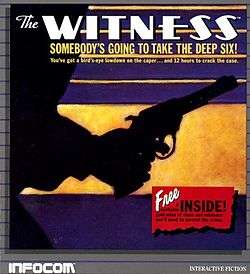The Witness (1983 video game)
| The Witness | |
|---|---|
 Cover art | |
| Developer(s) | Infocom |
| Publisher(s) | Infocom |
| Designer(s) | Stu Galley |
| Engine | ZIL |
| Platform(s) | Amiga, Amstrad CPC, Amstrad PCW, Apple II, Atari ST, Commodore 64, MS-DOS, TRS-80, TI-99/4A, Macintosh |
| Release date(s) |
Release 13: May 24, 1983
Release 18: September 10, 1983 |
| Genre(s) | Interactive fiction |
| Mode(s) | Single-player |
The Witness is an interactive fiction computer game published by Infocom in 1983. Like Infocom's earlier title Deadline, it is a murder mystery. The Witness was written in the ZIL language for the Z-machine, which allowed it to be released simultaneously on many popular computer platforms including the Apple II and the Commodore 64. It is Infocom's seventh game.
Plot
_screenshot.jpg)
The game takes place in Cabeza Plana, a quiet (and fictitious - the name is Spanish for "Flathead", an inside joke from Zork mythology) suburb of Los Angeles, California in February 1938. Freeman Linder, a local millionaire, has begged the police for protection from a man named Stiles. The player's character is a detective assigned one evening to check out the wealthy man's claims.
Is Linder seriously in danger or just another rich eccentric? Before the player can decide, a window explodes and Linder collapses, dead. The case of possible harassment has just become a murder, with the player as the only witness. With the help of Sgt. Duffy (last seen in Deadline), the player has until sunrise to solve the mystery. As usual, motive, method and opportunity must all be established to secure a "solid" arrest and the optimal ending.
Feelies
Included in each package of The Witness were the following supplementary items, called feelies:
- Virginia Linder's suicide note addressed to her daughter Monica
- A telegram from Freeman Linder pleading for protection from Stiles
- A matchbook from The Brass Lantern Chinese restaurant
- A February 1938 "issue" of the fictional magazine National Detective Gazette
- Two pages of a real issue of the Santa Ana newspaper The Register, with two fictional articles added about Virginia and Freeman Linder
Reception
Creative Computing wrote "Infocom has come up with another fine game with Witness ... If you have ever longed to work with Philip Marlowe, Miss Marple, or Lord Peter Wimsey, Witness is the next best thing."[1] Dan Gutman in Compute! stated that "The Witness is the latest in Infocom's masterful series in all-text adventures, and it may be their best one yet". He praised the game's feelies and period-accurate prose style, and said that the addition of Duffy avoided Deadline's tendency to "bog down". Gutman cautioned, however, that only those who enjoyed intricate puzzles would like The Witness.[2] BYTE agreed on the game's difficulty, and stated that author Stu Galley "apparently read enough of the [hard-boiled mystery] genre to emulate the style without mocking it", with "quick but thorough and evocative" descriptions. The magazine praised the feelies, and concluded that "Galley and the Infocom staff have succeeded in designing what Sherlock Holmes would call a 'three-pipe problem.'"[3] PC Magazine gave the game 11.0 points out of 12. It stated that the quality of the text parser and intricate plot balanced the "scant" 28 locations in the game.[4]
The Witness received the award for "1984 Best Computer Adventure" at the 5th annual Arkie Awards where judges warned those who thought text adventures were "passe" that the game had "run away with the Arcade Award" just as Infocom's previous text adventure, Deadline, had the previous year.[5]:28
References
- ↑ Arrants, Steve (December 1983). "Infocom does it again ... and again". Creative Computing. p. 153. Retrieved February 26, 2013.
- ↑ Gutman, Dan (December 1983). "The Witness". Compute!. pp. 182, 184. Retrieved 30 October 2013.
- ↑ Barker, Dennis (March 1984). "The Witness". BYTE. p. 301. Retrieved 17 January 2015.
- ↑ Wiswell, Phil (1985-01-22). "The Plot Thickens". PC Magazine. p. 245. Retrieved 28 October 2013.
- ↑ Kunkel, Bill; Katz, Arnie (February 1984). "Arcade Alley: The 1984 Arcade Awards, Part II". Video. Reese Communications. 7 (11): 28–29. ISSN 0147-8907.
External links
- The Witness at MobyGames
- The Witness overview
- Photo gallery of feelies included with The Witness
- The Infocom Bugs List entry for The Witness